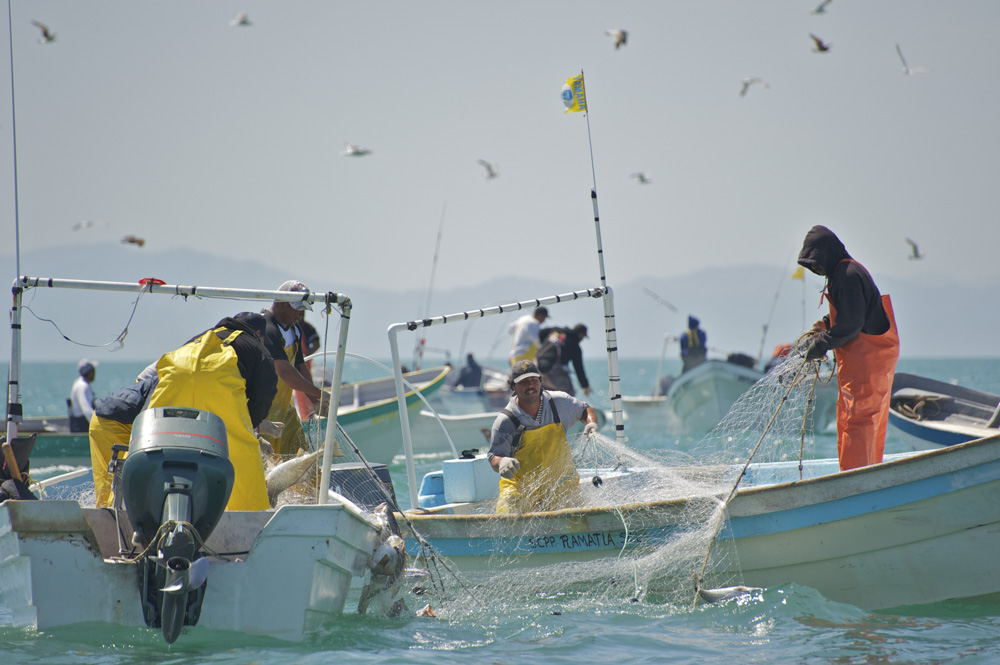Keywords:
Comparing two fishing communities in the Upper Gulf of California.

Fishing activity is essential for the social and economic well being of coastal communities around the world. Although 90% of fisheries are developed through coastal fleets (vessels around 7 meters long) (1), managing these fisheries is difficult since there isn’t always enough information that may help analyze the health of the targeted species’ population (2). The great challenge is to find out where the fishermen fish, what species they capture, how much work or effort they put into it, how much time they invest, and the effect the management policies have on their fishing activities. Incorporating this knowledge into management plans is crucial to protect the ecosystems, as well as the services they provide to the communities (3).

The Upper Gulf of California is one of the most important fishing zones in Mexico. Approximately 760 vessels (pangas) from El Golfo de Santa Clara, Sonora and San Felipe, Baja California work within the Upper Gulf of California and Colorado River Delta Biosphere Reserve (UGCCRDBR), fishing species such as: blue shrimp (Litopenaeus stylirostris), curvina golfina (Cynoscion othonopterus), bigeye croaker (Micropogonias megalops), Monterrey Spanish mackerel (Scombermorus concolor), as well as sharks, rays, crustaceans and bivalves.
However, this fishing fleet stands out because of its interaction with two priority species for conservation on an international level: the vaquita marina (Phocoena sinus) y la totoaba (Totoaba macdonaldi) (4, 5, 6). As a result, this region has a long history of conservation and management efforts from which the result was the creation of the UGCCRDBR. This reserve includes a nucleus zone to protect the spawning aggregations of the curvina golfina and the totoaba, as well as a vaquita marina refuge (7). In addition, the region is preparing to implement, starting on March 1st, a two-year ban on the use of gillnets and longlines, which represent a threat to the vaquita marina (8).
Even though these communities are separated only by approximately 83 km of sea, the coastal fisheries within the UGCCRDBR presents a geographic heterogeneity that has not been taken into account in current regulations. Through our Citizen Science Program, we have worked with fishermen in the region to generate and record information on the specific composition of fish catches, fishing effort, profits, reproductive seasons of species, as well as the spatial patters of fishing activities (9). In addition, we have added fishing data from CONAPESCA from 2001 to 2011, which include 35,902 records for the Gulf of Santa Clara and 31,861 for San Felipe.
Major findings: Our results have important implications for the management of fishery resources, because not only must we know how each of these fleets exploits the fisheries resources and ecosystems, but also how policy affects each of the communities. This knowledge will help us improve the design of management and conservation plans for fisheries to take care of natural resources and also to ensure the social and economic welfare of El Golfo de Santa Clara and San Felipe.
Authors:
Catalina López-Sagástegui*, Ismael Mascareñas-Osorio**, Brad Erisman***, Marcia Moreno-Báez**, Victoria Jiménez-Esquivel**, Octavio Aburto-Oropeza****
Contact Information:
DOI:
10.13022/M33S3C
Affiliations:
* UCMEXUS-UCR, California, EUA; ** CBMC, Baja California Sur, México; *** University of Texas, Texas, EUA; **** Scripps Institution of Oceanography, UCSD, California, EUA.
Acknowledgements:
We thank the fishermen of San Felipe and El Golfo de Santa Clara; Y. Flores, J. Vázquez, J. Montanez, L. Pérez, V. Corrales, H. Ruiz, A. Dominguez, R. Carrillo, C. Tirado, R. Franco, A. García, J. Cota-Nieto G. Hinojosa, A. Espinoza and Alto Golfo Sustentable for their support.
How to cite this story:
Catalina López-Sagástegui, Ismael Mascareñas-Osorio, Brad Erisman, Marcia Moreno-Báez, Victoria Jiménez-Esquivel, Octavio Aburto-Oropeza (2015): Comparing two fishing communities in the Upper Gulf of California. DataMares. InteractiveResource. http://dx.doi.org/10.13022/M33S3C
References
2. Salas, S., Chuenpagdee, R., Seijo, J.C., Charles, A., 2007. Challenges in the assessment and management of small-scale fisheries in Latin America and the Caribbean. Fish. Res. 87, 5–16.
3. FAO (Food and Agriculture Organization of the United Nations), 2005. Putting into Practice the Ecosystem Approach to Fisheries. FAO, Rome. 76 pp.
4. Aragón-Noriega, E.A., Rodríguez-Quiroz, G., Cisneros-Mata, M.A., Ortega-Rubio, A., 2010. Managing a protected marine area for the conservation of critically endangered vaquita (Phocoena sinus Norris, 1958) in the upper Gulf of California. Int. J. Sust. Dev. World Ecol. 17, 410–416.
5. Bobadilla, M., Álvarez-Borrego, S., Ávila-Foucat, S., Lara-Valencia, F., Espejel, I., 2011. Evolution of environmental policy instruments implemented for the protection of totoaba and the vaquita porpoise in the Upper Gulf of California. Environ. Science Pol. 14, 998–1007.
6. Ávila-Forcada, S., Martínez-Cruz, A.L., Muñoz-Piña, C., 2012. Conservation of vaquita marina in the Northern Gulf of California. Mar. Pol. 36, 613–622.
7. López Sagástegui, C., O. Aburto Oropeza, M. Moreno Báez, I. Mascareñas Osorio, G. Hinojosa Arango. 2014. Ciencia ciudadana en el alto Golfo de California: abriendo camino en el manejo pesquero y la conservación. CONABIO. Biodiversitas, 116:1-6.
8. CONANP. 2007. Programa de Conservación y Manejo Reserva de la Biosfera Alto Golfo de California y Delta del Río Colorado. SEMARNAT. México. 319 pp.
9. Acuerdo por el que se suspende temporalmente la pesca comercial mediante el uso de redes de enmalle, cimbras y/o palangres operadas con embarcaciones menores, en el norte del Golfo de California. Disponible en: http://207.248.177.30/regulaciones/scd_expediente_3.asp?ID=12/1657/231214

